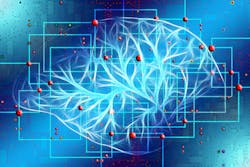Using AI to triage digital pathology cases
As digital pathology in clinical use becomes more prevalent, artificial intelligence (AI) algorithms are becoming an integral part of the conversation. The healthcare industry, overall, began adopting AI as the speed and accuracy of these technologies improved.
In pathology, the use of AI to analyze digital images and to aid in diagnosing disease, particularly in oncology, has the potential to improve the efficiency of workflows and the quality of results.
There are a variety of methods for developing AI tools, but the one most often used to assist pathologists is deep learning. A deep learning network masters highly complex observable features in images and their associated data.
To develop a deep learning algorithm, a team first must amass a large volume of digital-pathology images—including those with both negative and positive findings—and their associated microdata to include in training sets. Using the training data, the deep learning algorithm improves its performance.
Once an algorithm is designed, tested and commercially available, each lab will need to go through the validation process, which includes tuning the algorithm. The process of tuning involves determining how pathologists want the results of the AI tool to be applied to images. Once tuned, the algorithm is “locked,” which provides the lab and pathologists with the assurance that the tool in use is working as validated.
Triage of cases using AI
One of the best, first uses of AI or image analysis in the pathology workflow is the ability to automatically triage cases. The idea is to route patient cases first through the AI algorithm, which analyzes the images and forwards cases to pathologists based on criteria established by the lab. (Of course, the digital pathology platform will need the ability to support this process.) The AI algorithm can be applied to all cases or a subset of cases before they are assigned to a pathologist’s work queue.
When case information is matched with the whole slide images (WSIs), an algorithm can be applied to determine a variety of things. Some of the most useful are:
- Verifying that the digital images attached to the case actually belong to that case
- Validating that the tests ordered match the specimen type
- Identifying cases marked as stat
- Determining which cases have a higher probability of a positive result
- Determining which cases are most likely negative
Routing of cases using AI
Again, applying the image analysis and algorithms at the front end of the process provides the ability to route those cases to the appropriate locations. Those locations can be other labs (in a reference lab scenario), a pathologist’s worklist, lab case queues or to an administrator. All routing is based on the workflows, as defined by the lab and supported by the digital pathology solution that is deployed at the lab.
Lab managers often decide to route cases to improve overall efficiency and turnaround times. Within those broad parameters, the software can move cases higher or lower in the queue based on many factors. For example, urgent or complex cases can be assigned to a senior pathologist.
In the case of workload balancing, a lab might route a case with a high probability of a negative finding to a pathologist who has a heavier workload because it can be quickly signed out.
Even if cases are routed to accommodate scheduling, they can be rerouted quickly if a pathologist is called away or is out of the office. Other very effective uses of case routing include by sub-specialty, licensure, and customer preference.
The value of AI in oncology
Using AI software for triage of oncology cases can help pathologists in the diagnostic process in several ways. Algorithms can be run on the WSIs in advance to screen for PD-L1, HER2, ER, PR, Ki67—just to name a few. The results of these screenings then can be presented to the pathologist along with the case information and the images. The information presented to pathologists on the slide also can include grading, proliferation, scores, measurements, counts and classification of cell types. The software also can highlight regions of interest for the pathologist to focus on.
There are different types of algorithms available to the lab and the pathologist today. They range from stand-alone tools to those that are part of integrated digital-pathology solutions. Some tools are cloud-based and are offered as a service. In these situations, the lab sends the WSI or images showing a region of interest to the vendor and it performs the analysis at its location and returns the results. Other algorithms are part of an application or module installed at the lab, so the analysis is run onsite. Some products run their analyses in real-time with instantaneous (or near instantaneous) results, while other solutions have longer turnaround times—usually 12-72 hours.
The results of the AI being applied can also be combined with information from a robust digital pathology platform, such as a prior timeline or historical case information on each patient. This provides a significant advantage in all cases, but especially in oncology because pathologists see all prior diagnoses and any associated images from those previous WSIs. This helps pathologists assess disease progression or regression over time. Pathologists also can run algorithms on prior cases for a current association and perspective over time.
Leveraging AI for faster, more accurate diagnoses
In addition to using AI to triage and route cases, these solutions can be used to provide faster and more accurate diagnoses.
However, pathologists and other lab professionals have often expressed concerns that AI applications will replace highly trained professionals.
Data scientists, software engineers and other professionals, including pathologists, who are involved in developing the algorithms do not agree with those sentiments. Artificial intelligence and image analysis are meant to augment and support the work of pathologists.
Keep in mind how algorithms are developed. The input and expertise of pathologists is a key, core component of the development process. The images and associated datasets are used in the development, training and tuning of the models.
The metadata associated with each image—which includes demographics, diagnosis, scoring, measurements, cell identification and more—are all used, depending upon the type of algorithm being developed. Because these datasets are gathered globally, the collective knowledge of thousands of pathologists is incorporated into the development of the algorithms. At the level of an individual lab, a tool is not put into production until the pathologists who will be using it are satisfied with its performance.
In addition to helping with the identification of potential tumors, these tools could undertake some of the tedious and routine aspects of pathology, such as counting mitosis. This approach would allow trained pathologists to focus on the parts of each case that involve clinical interpretation and diagnosis.
AI tools for use cases throughout the lab
AI algorithms are built for very specific use cases. There are literally thousands on the market or in development today for anatomical pathology, as well as other areas of clinical laboratories. Lab managers simply need to determine the problem, or problems, they are trying to address and then search for a vendor with an appropriate solution. Some vendors offer custom development services. At some labs with lab-developed tests, managers may opt to purchase an algorithm that is developed solely for their use while performing the test.
Laboratories can choose from the variety of algorithms to determine the one(s) that are best for their objectives and workflow.
It is a very exciting time in pathology. Both digital pathology and AI have advanced remarkably in the past five years and are being adopted in clinical workflows every day. It will be interesting to see how the uses for AI and digital pathology in the lab continue to develop over the next five years.
About the Author

Lisa-Jean Clifford
Lisa-Jean Clifford has been a noteworthy leader in the high-tech healthcare solutions space for more than two decades. Lisa-Jean’s passion for making a positive impact on the lives of patients through technology can be traced back to her tenure at McKesson and IDX, now GE Healthcare, where she served in vital business development and marketing roles, and to Psyche Systems, an LIS solution provider, where she was the CEO for eleven years. She is currently the President at Gestalt Diagnostics.
Now, recognized as an industry expert, she actively participates in numerous boards including the Association of Pathology Informatics where she serves as President and MLO’s Editorial Advisory Board. She is widely published in many top laboratory publications and noteworthy news sources, such as Forbes, CAPToday, Medical Laboratory Observer, and Health Data Management. Also, she is a highly sought-after speaker and focuses on delivering valuable content in critical areas such as lab automation including software and interoperability, digital pathology, AI in pathology, lab informatics, oncology, and women’s health.
